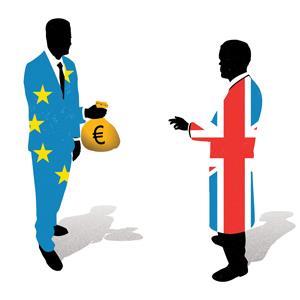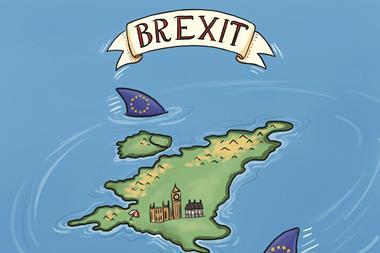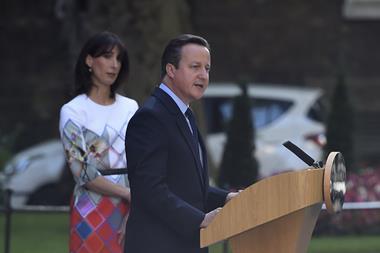On 23 June, UK citizens will be asked whether they want to remain in the EU. What will the consequences be for science? Jon Cartwright finds out

‘No, no, no.’ That was the famous response of Margaret Thatcher – one-time chemist and then the UK prime minister – to the prospect of stronger ties with the European Union (EU), in a speech to the House of Commons on 30 October 1990. It was a doomed stance: not only was she forced to resign as leader of the Conservative party less than a month later, but each of her next three prime ministerial successors – fellow Conservative John Major, and Tony Blair and Gordon Brown of the Labour party – oversaw steps towards closer economic and political integration between the UK and the EU.
The UK has always had an awkward relationship with the EU, and arguments around membership have never been laid to rest. Upon entering his second term as prime minister in 2015, fuelled by growing Euroscepticism in the Conservative party and nationwide, David Cameron pledged to hold a referendum to decide the future of the UK’s membership. The date of that referendum has now been set: 23 June. Campaigns are well underway, with free movement of people, sovereignty, trade agreements and membership costs being a few of the central issues under debate.
Horizon 2020 will have a €75bn budget – and UK scientists will hope to grab at least 10% of it
For most voters, science will not be one of these issues. But as some argue, the outcome of the referendum has the potential to greatly affect the future of the scientific enterprise – in the UK and elsewhere, for better or for worse. In February, more than 100 university leaders signed an open letter claiming that a British exit, or Brexit, could ‘undermine the UK’s position as a global leader in science, arts and innovation’; a month later, more than 150 fellows of the Royal Society, among them the British cosmologist Stephen Hawking, signed a letter to The Times arguing that, for science, leaving the EU could be a ‘disaster’. Certainly there are plenty of vocal scientists insisting on the necessity of EU membership. On the other hand, there is a significant minority who believe that leaving would, at worst, have a negligible effect on science. It is an uncertain time for UK and EU scientists: as this issue went to press, polls suggest a slim lead for voters wanting to remain over those wanting to leave.
Strong player
The primary means with which the EU delivers research funding is through the Framework Programmes (FPs; see box: Long history). The framework programme for the current 2014–2020 period – technically FP8, but known commonly as Horizon 2020 – has an expected budget of €75 billion (£59 billion). Funding within the FPs is managed by a number of different mechanisms, but perhaps the two most important for science (as opposed to innovation) are the European Research Council (ERC) for basic research and the Marie Sklodowska-Curie Actions, which support high-achieving scientists if they are prepared to further their careers abroad. Yet the Framework Programmes account for just a portion of R&D spending by the EU: at present, on top of several smaller niche programmes, there is a €5 billion pot for ‘sectoral’ research (one recipient being the Iter nuclear fusion experiment in Cadarache, France) and a €40 billion pot for structural investment, which primarily goes towards upgrading infrastructure. In total, over the period 2014–2020, the EU expects to spend €120 billion on R&D.
Long history
The EU has had a hand in science since its beginning in 1951 as the European Coal and Steel Community (ECSC), a partnership made in the aftermath of the second world war between various war-torn nations of continental Europe to prevent future conflict. Besides forming a common market for coal and steel – vital wartime commodities – the ECSC provided funding for research into those industries. In 1957, the scope of economic integration broadened with the formation of the European Economic Community (EEC); at the same time, the membership states also established the European Atomic Energy Community for research into the emerging field of nuclear power. The UK joined the EEC in 1973 (after years of hesitation on the part of French president Charles de Gaulle).
But it was only in the 1980s that the EEC instigated its best known vehicle for research and development: the Framework Programmes (FPs). The early FPs had fairly small budgets and were primarily targeted at managing energy resources and improving the competitiveness of European industries. By 1994, however, with the launch of the FP4, the budget had increased to €13 billion (£10 billion), bringing a new focus on areas such as the life sciences, the environment and socio-economics, as well as an aim to improve the mobility of and cooperation between European researchers. This came shortly after the ratification of the Maastricht treaty, which turned the EEC into the EU.
The FPs continued to evolve with the EU’s needs, recently pioneering large collaborations between public institutions and private companies, and coordinating research via the European Research Area (ERA), which was formed in 2000. Seven years later, thanks to the Lisbon Treaty, the EU could begin coordinating basic research, which it had previously neglected. This came in FP7 with the formation of the European Research Council (ERC), and a massive budget of €56 billion.
The eighth and latest FP, known as Horizon 2020 (rather than FP8), has seen funding dramatically increase again, to €75 billion, despite commencing in the wake of the global financial crisis. The overarching goal has been to address what are seen as international ‘societal challenges’: health, food security, clean energy, transport, climate change, societal inclusivity and security.
Broadly speaking, the UK does relatively well when it comes to allocation of this funding. Drawing on data from the UK’s Office for National Statistics, the Royal Society estimates that, despite contributing just €5.4 billion to EU R&D, the UK received €8.8 billion (11%) of EU R&D funds during the period 2007–2013 (projected figures for the current Horizon 2020 period are not available) The UK does particularly well when it comes to competitive funding, with 78% of its share for that period being won in this way. Theoretical physicist Peter Tindemans of EuroScience, an independent, not-for-profit organisation based in France that aims to promote the interests of scientists in Europe, believes these figures reflect the inherent quality of UK education and research – from which, he says, all member states profit. ‘I am pretty convinced that not only UK scientists, but also most European scientists, feel that [Brexit] would not be a good move,’ he adds. ‘One reason is that the UK is a very strong scientific nation – it plays a major role.’
Still, the EU R&D contribution is small when compared with the UK’s overall R&D spending. The Royal Society estimates that FP7 accounted for just 3% of UK R&D funding over 2007–2013 – far less than that delivered by higher education funding councils (8%), research councils (8%), government departments (11%) or the private sector (45%). The proportion of funding received from the EU in universities alone is somewhat higher, at about 10%. Despite doing well out of competitive funding, the UK does poorly out of EU structural funding, most of which goes towards member states with relatively underdeveloped scientific infrastructure, such as Poland, Italy and Spain. And as Eurosceptics point out, the EU R&D contribution to the UK is dwarfed by the size of the UK’s net EU membership contribution: out of a total €78 billion the UK paid to the EU over the FP7 period, it received €48 billion – a net contribution of €30 billion.

If the UK left the EU, that net contribution could easily plug the hole left by EU R&D, according to Eurosceptics. ‘The sums will not be touched,’ says Stephen Bush, a consultant polymer and chemical engineer, and a longstanding campaigner against UK membership of the EU. ‘It will just be that the Treasury sends them to universities directly, rather than sending them via Brussels.’ In general, Bush believes that pro-EU scientists focus too much on levels of science funding, and focus too little on where exactly that funding is directed. ‘Merely generating knowledge inside a university will not do anything for our country’s ability to fund science in the future,’ he says. ‘The real challenge is how to deploy our science into technology, and then into business.’
Andrew Steele, a computational biologist at the Francis Crick Institute in London, takes issue with that view. A co-founder of a campaign called Scienceogram that aims to place science funding in a broader economic context, he points out that science investment has already been shown by various studies to generate a high return to the UK economy. He also believes the track record of the UK government on science has not been good: in 2010 the UK’s public science budget was allowed to fall in real terms (owing to inflation) for five years, and only last year was frozen. ‘In theory we could pull out of the EU and spend some of that former net contribution on science,’ says Steele. ‘But you’ve got to ask yourself, would a future government take this step? I think, given the record of the government over the past five years, the answer is probably no.’
Like many other scientific societies, the Royal Society of Chemistry, which publishes Chemistry World, does not have an official position on the referendum. In November, it submitted evidence to the UK House of Lords’ science and technology select committee in which it described EU membership as having had a ‘mostly positive influence’ on UK science. The committee’s report, published in April, found that UK businesses are lagging behind competitor nations seeking EU funding, while UK universities are reaping rewards.
The big question
Europe’s collaborative tradition in science is not totally down to the EU. Plenty of world-class European scientific facilities – the European Synchrotron Radiation Facility, the Cern particle physics lab, the European Space Agency and many more – formed independently of the EU via multilateral agreements (although some have since formed ties to the EU). Drawing scientists from far and wide, many of these facilities have come to be seen as bastions of internationalism.

It is also true that nations do not need to be part of the EU to be involved in EU-managed R&D. Since 2002, non-member states have been able to access all aspects of the Framework Programmes either as ‘associated countries’, which make fixed contributions proportional to their GDP, or as ‘third countries’, which proceed on a more ad-hoc basis. There are currently 13 associated countries, including Norway, Israel and Turkey. If the UK left the EU, it could apply for associated status to remain involved in Horizon 2020 and future Framework Programmes, although its success would almost certainly depend on the outcome of other EU negotiations. Due to recent disagreements with Brussels, Switzerland has seen its status demoted to ‘partial association’, and it is now a continual source for debate among pro- and anti-EU scientists (see box: ‘The Swiss model’).
If it did become an associated country, the UK could fully participate in Horizon 2020, and UK scientists could still evaluate the merit of competitive EU funding applications, as other non-EU scientists already do. But the UK would not be directly involved in steering the goals of EU R&D in its interests.
In any case, of more importance to UK and European scientists than the UK’s status in Horizon 2020 is its approach to freedom of movement. This is fundamental to the underpinnings of the EU, for all workers and particularly in recent years for scientists, as part of the ERA’s ‘open market for researchers’. Immigration is probably the biggest subject under scrutiny in the general EU referendum debate, but there is little agreement on what the policies would be post-Brexit. If the UK remains in the EU’s single market then freedom of movement would probably be retained; if it does not, then UK scientists will require visas to work in EU countries, and vice versa.
The Swiss model
The Swiss model Switzerland, a non-EU country, is widely seen as a model of what could happen to the UK if it leaves the EU and instigates reforms that go against EU ambitions. Just three years ago, Switzerland was an associated country of the EU, meaning that it had exactly the same rights to participate in the Framework Programmes as EU member states. But in early 2014 it held a referendum on whether to restrict immigration, a policy that would go against the EU’s principle of free movement of people: just over half (50.3%) of the Swiss population voted in favour. The outcome was a double whammy for Swiss relations with Brussels, as it also meant that the Swiss government felt unable to sign a pending free-movement accord with Croatia, which had joined the EU the previous year.
Free movement is not an absolute criterion for associated- country status; Brussels considers applications case by case. (Israel, an associated country, neither has freedom of movement nor any borders with other EU member states.) But in Switzerland’s case, the loss of free movement was clearly too much to bear, and Brussels saw fit to give it only a ‘partial association’ status for Horizon 2020. That status expires in February next year, although given that the country signed the Croatia deal in March this year, it is expected to revert to full association.
Under Switzerland current partial association, it only has access to the so-called ‘excellence’ parts of Horizon 2020, such as the ERC and Marie Sklodowska-Curie grants; it cannot coordinate projects, and small businesses cannot apply for funds. Whether this has been detrimental to Swiss science is a matter for debate. Pro-EU campaigners claim that Swiss involvement in Horizon 2020 has dropped by 40%; in contrast, anti-EU campaigners claim that, taking funding per captia, Switzerland is still more involved in Horizon 2020 than the UK, Germany, France and Spain. Only one point the Swiss model does make clear: in a Brexit scenario, no-one knows exactly what to expect from Horizon 2020. An EU representative says: ‘The European Commission is not speculating about what might happen if the UK left the EU.’
Scientists for Britain, a group campaigning for Brexit, believes such uncertain issues will in practice have a negligible influence on science, and that voters ought to make up their minds based on their broader political views. ‘We would like to remind readers that the forthcoming referendum is not a vote on our membership of a science club; it is a vote on whether we wish to remain part of a political union that has openly declared its federalist ambitions, some of which already impact on our daily lives,’ reads a statement on the Scientists for Britain website. Its counterpart group, Scientists for EU, believes that, at best, this stance ignores the body’s proven track record of success when it comes to research. ‘We can say that, for science, these multinational frameworks are great for mobility, and the common policy setting is great,’ says Mike Galsworthy, the group’s leader. ‘Our experience is a positive one.’
Scientific truths are not established by popular vote. Perhaps unfortunately for scientists, the UK’s membership of the EU will be. ‘No, no, no’, or ‘Yes, yes, yes’: in just a few weeks, we will know the answer.
Jon Cartwright is a freelance journalist based in Bristol, UK












No comments yet